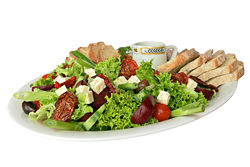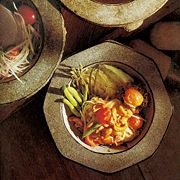Salad

Salad is a mixture of cold foods, usually including vegetables and/or fruits, often with a dressing, occasionally nuts or croutons, and sometimes with the addition of meat, fish, pasta, cheese, or whole grains. Salad is often served as an appetizer before a larger meal.
The word "salad" comes from the French salade of the same meaning, which in turn is from the Latin salata, "salty", from sal, "salt", (See also sauce, salsa, sausage).
Contents |
History
The diarist John Evelyn wrote a book on salads, Acetaria: A Discourse on Sallets (1699), that describes the new salad greens like "sellery" (celery), coming out of Italy and the Netherlands. Recently, salads have been sold commercially in supermarkets for those who do not have time to prepare a home-made salad, at restaurants (restaurants will often have a "Salad Bar" laid out with salad-making ingredients which the customer will use to put together their salad) and at fast-food chains specialising in health food. Fast-food chains such as McDonalds and KFC, that typically sell "junk food" such as hamburgers, fries and fried chicken, have begun selling packaged salads in order to appeal to the health-conscious.
Green salad

The "green salad" or "garden salad" is most often composed of some vegetables, built up on a base of leaf vegetables such as one or more lettuce varieties, spinach, or rocket (arugula). The salad leaves are cut or torn into bite-sized fragments and tossed together (called a tossed salad), or may be placed in a predetermined arrangement.
Other common vegetables in a green salad include cucumbers, peppers, mushrooms, onions, spring onions, red onions, avocado, carrots, celery, and radishes. Other ingredients such as tomatoes, pasta, olive, hard boiled egg, artichoke hearts, heart of palm, roasted red peppers, cooked potatoes, rice, sweetcorn, green beans, black beans, croutons, cheeses, meat (e.g. bacon, chicken), or fish (e.g. tuna, shrimp) are sometimes added to salads.
Entree salads may contain chicken, either grilled or fried chicken fingers on top of the salad, or seafood in the form of grilled or fried shrimp, or a fish steak, such as tuna, mahi-mahi, or salmon. Steak such as sirloin can be grilled and sliced and placed upon the salad. Caesar salad, Chef salad, Cobb salad, Greek salad and Michigan salad are types of green salad.
Dressings
The concept of salad dressing varies across cultures. There are many commonly used salad dressings in North America. Traditional dressings in southern Europe are vinaigrettes, while mayonnaise is predominant in eastern European countries and Russia. In Denmark dressings are often based on crème fraîche. In China, where Western salad is a recent adoption from Western cuisine, the term salad dressing refers to mayonnaise or mayonnaise-based dressings. Many light edible oils are used as salad dressings, including olive oil, corn oil, soybean oil, safflower oil, etc.
- Balsamic vinegar
- Caesar dressing
- Bleu cheese or blue cheddar dressing
- Louis dressing
- Ranch dressing
- Russian dressing
- Honey Dijon
- Thousand Island dressing
- French dressing
- Italian dressing
- Vinaigrette
- Wafu dressing
- Tahini
- Hummus
Garnishes
Popular salad garnishes are anchovies, bacon bits (real or imitation), beetroot bell peppers, shredded carrots, cress, croutons, parsley, mushrooms, onions, radishes, sunflower seeds (shelled), surimi - artificial crab meat and cherry tomatoes.
Other types of salad


Salads that include ingredients other than fresh vegetables are:
- Antipasto salad
- Bean salad
- Chef salad
- Chicken salad
- Chinese chicken salad
- Coleslaw
- Congealed salad
- Crab Louie salad
- Egg salad
- Eggplant salad
- Fattoush
- Fruit salad
- Ham salad
- Israeli salad
- Larb
- Niçoise salad
- Panzanella
- Pasta salad
- Potato salad
- Russian salad
- Salmagundi
- Shopska salad
- Somen salad
- Som tam
- Gỏi ngó sen - a Vietnamese salad
- Tabouli
- Taco salad
- Tuna salad
- Waldorf salad
- Watergate salad
Largest salad
On September 29, 2007, Pulpí, in Almería, Spain tossed the world's largest salad, with 6,700kg (14,740lb) of lettuce, tomato, onion, pepper and olives, supervised by 20 cooks over 3 hours. A Guinness World Records judge was present to confirm the new record. The salad was prepared in a container 18m (59ft) long and 4.8m (15.7ft) wide.[1]
References
|
|||||||||||||||||